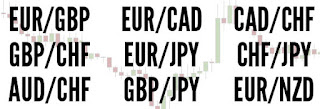With Forex trading becoming a more extended and desired occupation for lots of people around the world, living with the desire of working at home and still having the ability to gain a full time income, the need for accurate trading systems and techniques has become a major necessity for all these new forex traders.
Among one of the important concepts a new forex trader should know is what a Moving Average means, how it's calculated and what its use as a trading indicator is.
Moving Average is defined as a technical indicator that shows the average value of a particular currency pair over a previously determined amount of time. This means, for example, that prices are averaged over 20 or 50 days, or 10 and 50 min depending on the time frame you are using at the moment of your trading activity.
As an averaged quantity, MA's can bee seen as a smoothed representation of the current market activity and an indicator of the major trend influencing the market behavior.
This smoothing effect of the Moving Average is very helpful when the trader is looking for getting rid of the "noise" in the price fluctuations of the currency pair he is trading at the moment and a more precise emphasis in the trend direction is required.
The basic mechanics of how Moving Averages can tell you where the forex market is moving (up or down), at the moment of your analysis is by considering two different time frame Moving Averages and plotting them on the forex chart. It is very important that one of these MA is over a shorter time period than the other one; let's say one will be over a 15 days period and the other over a 50 days period. Most trading station software available by a number of brokers will let you do this plotting and much more.
Once you have plotted the two Moving Averages, you will notice points of crossover where the shorter time period MA will cross above the longer time period MA indicating an upward trend in the market, or if the crossing is below the longer period MA that will be an indication of a down trend in the forex market.
So from this simple concept you can commence to understand the basics of confirming trends when checking your forex charts during your trading hours on MT4 platform by Trust Capital.
Among one of the important concepts a new forex trader should know is what a Moving Average means, how it's calculated and what its use as a trading indicator is.
Moving Average is defined as a technical indicator that shows the average value of a particular currency pair over a previously determined amount of time. This means, for example, that prices are averaged over 20 or 50 days, or 10 and 50 min depending on the time frame you are using at the moment of your trading activity.
As an averaged quantity, MA's can bee seen as a smoothed representation of the current market activity and an indicator of the major trend influencing the market behavior.
This smoothing effect of the Moving Average is very helpful when the trader is looking for getting rid of the "noise" in the price fluctuations of the currency pair he is trading at the moment and a more precise emphasis in the trend direction is required.
The basic mechanics of how Moving Averages can tell you where the forex market is moving (up or down), at the moment of your analysis is by considering two different time frame Moving Averages and plotting them on the forex chart. It is very important that one of these MA is over a shorter time period than the other one; let's say one will be over a 15 days period and the other over a 50 days period. Most trading station software available by a number of brokers will let you do this plotting and much more.
Once you have plotted the two Moving Averages, you will notice points of crossover where the shorter time period MA will cross above the longer time period MA indicating an upward trend in the market, or if the crossing is below the longer period MA that will be an indication of a down trend in the forex market.
So from this simple concept you can commence to understand the basics of confirming trends when checking your forex charts during your trading hours on MT4 platform by Trust Capital.





















